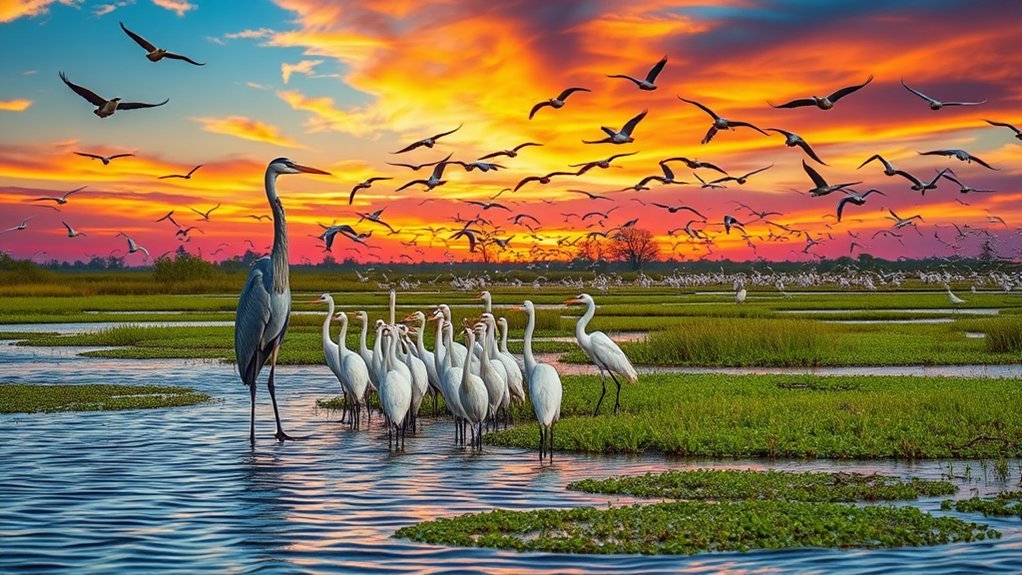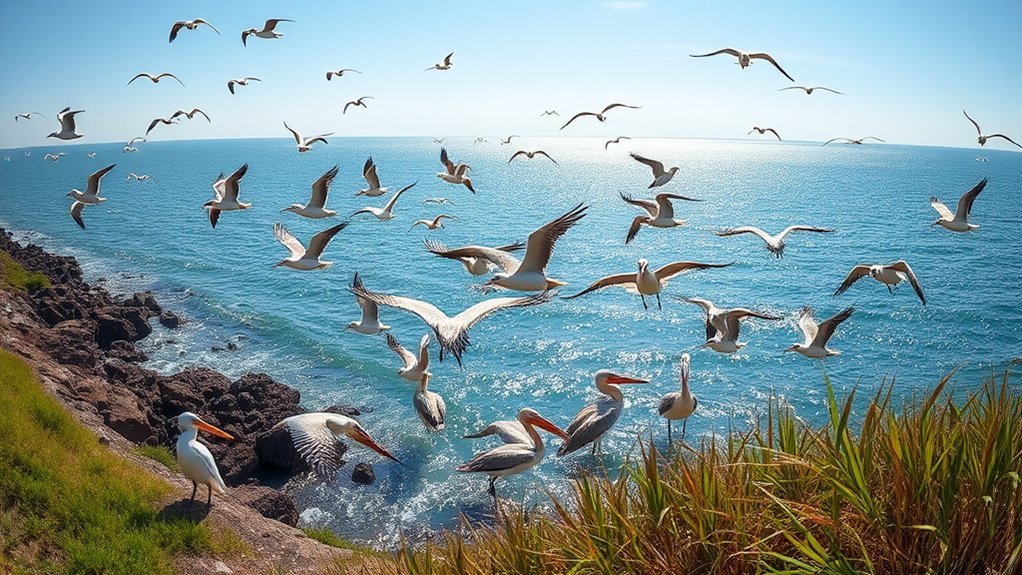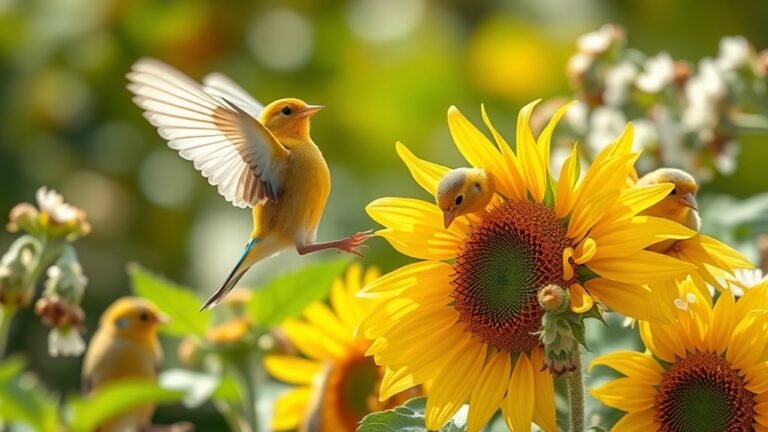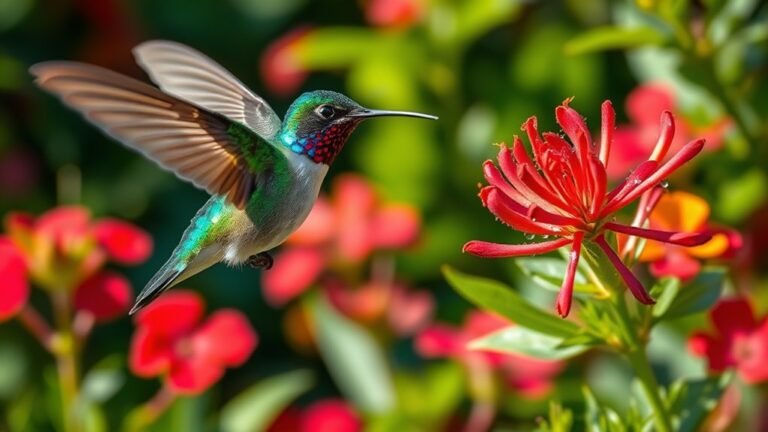Birds in South Carolina: Native and Migratory Species
South Carolina has many types of birds due to its varied habitats. You can find native birds like the Carolina Wren and Northern Cardinal. These species live here all year. Migratory birds visit during certain seasons, adding to the state's bird diversity. Each bird plays a crucial role in its environment. Their behaviors and interactions affect the overall health of their habitats. It is important to understand these dynamics for conservation efforts. How do these changes influence South Carolina's natural environments?
Key Takeaways
South Carolina has various bird habitats such as wetlands, marshes, forests, and coastal areas. These habitats are important for both resident and migratory birds.
Native birds like the Carolina Wren, Eastern Bluebird, and Northern Cardinal live in the state's ecosystems.
Seasonal migratory birds, such as the Eastern Whip-poor-will and Black-throated Green Warbler, increase local bird diversity at certain times each year.
Threatened species, such as the Red-cockaded Woodpecker and Least Tern, show the need for habitat conservation in South Carolina.
Birdwatching spots like Congaree National Park and Santee National Wildlife Refuge provide great chances to see both native and migratory birds.
Overview of South Carolina's Bird Habitats

South Carolina has many different bird habitats. These habitats are important for migratory birds and provide homes for many species that live here year-round. The state includes wetlands, marshes, forests, and coastal areas, which support a wide variety of birds. From shorebirds to songbirds, these habitats show how interconnected life can be in nature.
To keep this bird diversity healthy, habitat conservation is essential. Protecting wetlands and forests not only safeguards individual bird species but also supports the entire ecosystem.
Participating in local conservation projects can build community spirit and responsibility. Learning about these habitats can motivate people to work together to protect South Carolina's bird life for the future.
Common Native Birds of South Carolina
South Carolina offers a variety of habitats that support many native birds. The Carolina Wren is known for its beautiful song and is often found in wooded areas and gardens.
The Eastern Bluebird frequently perches on fence posts, showcasing its bright colors in open fields.
In wetlands, the Great Egret hunts for fish, highlighting the importance of diverse habitats for wildlife.
The Northern Cardinal adds color to backyards with its vibrant red feathers and cheerful call.
Threatened and Endangered Bird Species

Urban development and climate change are changing habitats in South Carolina, putting several bird species at risk. The Red-cockaded Woodpecker and the Least Tern are two of the most vulnerable species. Their dwindling numbers show that conservation and habitat protection need immediate attention.
You can help by supporting local organizations that work on habitat restoration and environmental education.
Raising awareness about the challenges these birds face can build community spirit as people unite to protect South Carolina's bird species. Promoting eco-friendly practices and advocating for better environmental policies ensures that future generations will enjoy the diverse birdlife in our region.
Together, we can strengthen our efforts to protect these valuable species.
Seasonal Migratory Birds: An Overview
Habitat changes from urban development and climate impact seasonal migratory birds in South Carolina. These birds follow specific migration patterns and travel thousands of miles to find food and breeding grounds.
For example, the Eastern Whip-poor-will and Black-throated Green Warbler arrive in spring because of warmer temperatures and blooming flowers.
Learning about these migration patterns helps us appreciate our ecosystems. Watching these birds journey can enhance our landscapes and support biodiversity.
Participating in local conservation efforts can protect important habitats. This ensures that these migratory birds continue to enhance our skies, connecting our community with nature.
Coastal and Marine Birds

When you visit the coastlines of South Carolina, you'll see various coastal and marine birds.
These birds are important for understanding the health of marine ecosystems and shorebird habitats. Here are some interesting birds you may notice:
- Royal Terns: They've black caps and fly gracefully.
- Black Skimmers: They've unique bills that help them catch fish.
- Piping Plovers: These are threatened shorebirds that need sandy beaches to nest.
- Great Egrets: They're elegant hunters living in wetlands and coastal areas.
Each species plays a role in the coastal ecosystem. Observing these birds helps you appreciate South Carolina's rich biodiversity and highlights the importance of protecting their habitats.
Forest and Woodland Birds
South Carolina has more than 50 species of birds in its forests. Each bird plays a role in the woodland ecosystem. Common birds include the Carolina Chickadee and the Red-shouldered Hawk. These birds show how different species depend on each other.
Watching birds can reveal important information about the health of these forests. You can learn about their foraging and nesting habits. During seasonal changes, resident and migratory birds interact, showing key ecological processes.
This connection helps foster a greater appreciation for nature. Engaging with these birds not only enhances your knowledge but also deepens your bond with South Carolina's diverse wildlife. This encourages us to care for and value our vital habitats.
Wetland and Waterfowl Species
Many birds live in South Carolina's wetlands, offering a variety of waterfowl species that are vital to these areas. Knowing about these birds helps you appreciate nature.
Key waterfowl species include:
- Northern Pintail
- American Black Duck
- Wood Duck
- Lesser Scaup
Wetlands provide important support for these species during waterfowl migration. They offer habitat for nesting, feeding, and resting.
This habitat allows for many bird interactions and ecological processes. Watching these beautiful birds in their natural setting reveals their significance in keeping wetlands healthy.
Understanding their role creates a connection to the vibrant life in South Carolina.
Urban Birds: Adapting to Human Environments
As cities grow, many bird species have adapted to live in these environments.
Birds like rock pigeons, sparrows, and mockingbirds are now common in urban areas. They use buildings for nesting and search for food in the leftovers humans leave behind.
These birds change their behavior to manage busy streets and loud noises, whereas other bird species may avoid them.
Access to food and safe nesting sites in parks and green spaces is crucial for their survival.
Birdwatching Hotspots in South Carolina
South Carolina features a variety of birdwatching spots suitable for all levels of bird enthusiasts. The state hosts different habitats, including coastal marshes and mountains, supporting numerous bird species.
Here are notable locations for birdwatching:
- Congaree National Park: Look for warblers and woodpeckers here.
- Santee National Wildlife Refuge: This area is great for spotting waterfowl and raptors.
- Myrtle Beach State Park: This site is excellent for observing shorebirds during their migration.
- Francis Marion National Forest: Discover a range of woodland bird species in this forest.
Local groups often organize guided tours and events, creating opportunities for birdwatchers to connect with one another.
Dive into the joys of birdwatching at these wonderful locations!
The Importance of Birds in Ecosystems
Birds are important for healthy ecosystems. They show us the quality of the environment. Their presence helps us understand biodiversity and the health of habitats.
Birds help maintain balance in nature by pollinating flowers, spreading seeds, and controlling pests. This support creates a sustainable environment.
When we support bird conservation, we help protect these vital species and their habitats. Conservation efforts build a sense of community as people come together to protect nature.
Flourishing bird populations indicate that ecosystems are doing well, which benefits all living things. Knowing how important birds are for our environment increases our appreciation for nature.
It also reminds us of our responsibility to protect the delicate balance of our planet's ecosystems. Engaging in bird protection efforts can bring joy and a deeper connection to the natural world around us.
Tips for Birdwatching in South Carolina
To enjoy birdwatching in South Carolina, follow these simple tips. They'll help you see and appreciate the variety of birds in the area.
- Use good equipment like binoculars and field guides.
- Visit well-known spots such as Congaree National Park or the ACE Basin.
- Go early in the morning or later in the afternoon when birds are most active.
- Stay quiet and still. Gentle movements can help you see shy birds.
By engaging in birdwatching, you'll connect more with nature and meet others who share your interest in birds.
Enjoy the beauty of South Carolina's wildlife!
Frequently Asked Questions
What Are the Best Times of Year for Birdwatching in South Carolina?
The best times for birdwatching in South Carolina are spring migration and winter feeding. In spring, many bird species return after migrating, making it an exciting time to observe them. In winter, birds gather to search for food, creating opportunities to see various species. Understanding these patterns can deepen your enjoyment of birdwatching and help you connect with the diverse bird life in the area.
How Can I Attract Birds to My Backyard in South Carolina?
To attract birds to your backyard, set up bird feeders filled with seeds and plant native plants. This will create a friendly space for birds, giving them food and shelter. These actions not only help birds but also improve the variety of wildlife in your area. Enjoy watching the birds as they visit your yard!
What Resources Are Available for Bird Identification in South Carolina?
For bird identification in South Carolina, consider using birding apps like Merlin Bird ID. Local field guides also provide valuable information. These resources offer clear descriptions, helping you learn about local birds and connect with other bird watchers.
Are There Any Birding Festivals or Events in South Carolina?
South Carolina hosts several birding festivals throughout the year. These festivals include expert-led birding tours and workshops focused on bird identification skills. They also feature community gatherings aimed at promoting conservation efforts. These events offer a great opportunity to connect with fellow birding enthusiasts and share your passion for birds.
How Can I Report Sick or Injured Birds in My Area?
If you see a sick or injured bird, please contact a local bird rescue or wildlife rehabilitation center. These organizations can give you specific advice and help ensure the bird gets the care it needs to heal.

Kashvi is a passionate bird enthusiast and nature lover who has been fascinated by the world of birds for years. With a keen eye for detail and a love for learning, Kashvi is dedicated to sharing her knowledge and insights with fellow bird enthusiasts on Avian Enthusiasts. Through her engaging and informative articles, Kashvi aims to inspire others to join her in exploring the fascinating world of birds and to promote a deeper appreciation for these incredible creatures.







